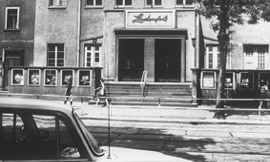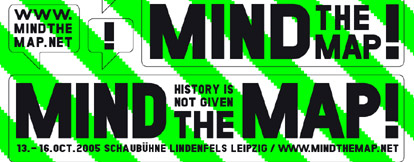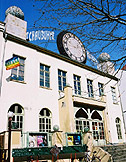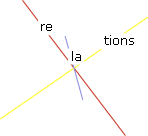|
|



FormatsSeminars, exchange between the participating university partners, international symposium, publication of research resultsProject leadership and co-ordinationProf. Dr. Marina Gržinić, Academy of Fine Arts, Vienna; Prof. Dr. Günther Heeg, Dr. Veronika Darian, Institute for Theater Studies, University of LeipzigParticipating academics and institutionsProf. Dr. Beatrice von Bismarck (Academy of Visual Arts, Leipzig); Prof. Dr. Ekaterina Degot (Institute of Contemporary Art, Moscow); Prof. Dr. Grzegorz Dziamski (Academy of Fine Arts, Poznań); Dr. Michael Fehr, Karin Schad (Karl Ernst Osthaus-Museum, Hagen); Dr. Werner Fenz (Karl-Franzens-University, Graz); Prof. Dr. Miško Šuvaković (University of Fine Arts, Belgrade)Young ResearchersBojana Cvejić (University of the Arts - Faculty of Music, Belgrade);Dr. Veronika Darian (University of Leipzig - Institute of Theatre Studies, Leipzig); Antje Dietze (University of Leipzig - Institute of Theatre Studies, Leipzig); Roman Grabner (Karl-Franzens-University - Institute of Art History, Graz); Karoline Kaluza (University of Bonn - Institute of Art History, Bonn); Alexander Koch (Academy of Visual Arts, Leipzig); Maxim Krekotnev (Institute of Contemporary Art, Moscow); Ralo Mayer and Philipp Haupt (Academy of Fine Arts and University of Applied Arts, Vienna); Mirjana Peitler (Karl-Franzens-University - Institute of Art History, Graz); Marko Stamenković (University of the Arts - Interdisciplinary Postgraduate Studies, Belgrade); Šefik Šeki Tatlić (University of Sarajevo - Faculty of Political Sciences, Department of Journalism); Michael Wehren (University of Leipzig - Institute of Theatre Studies, Leipzig); Ewa Wójtowicz (Academy of Fine Arts, Poznan); Anya Zaytseva (Institute of Contemporary Art, Moscow); Jacek Zydorowicz (Adam Mickiewicz University - Institute of Cultural Studies, Poznan) Artistsfrankfurter küche Leipzig (Kattrin Deufert and Thomas Plischke) and Greta Gancheva, Mila Odazieva, Willy Prager and Maya Stefanova(Sofia);Konstantinos Goutos, Academy of Visual Arts, Leipzig; Clemens von Wedemeyer; Marc Tobias Winterhagen, Academy of Visual Arts, Leipzig; Harv Stanić, artistic collaborator at the Experimental Radio, Bauhaus University, Weimar; IRWIN: Miran Mohar, Borut Vogelnik, Andrej Savski, Ljubljana TeamAntje Dietze, Carsten Göring, Hilke Werner, Sophie Witt, Christiane Richter (University of Leipzig)Kindly supported bySlovene Ministry of Culture, German Academic Exchange Service DAAD, Nationales Performance Netz NPN, Goethe-Institut Sofia in the framework of the Stability Pact for South Eastern EuropeMedia partnersARTCHRONIKA, ARTeon, TkH, Umělec, springerin |
The "East Art Map" University Network is aimed to build a platform for the discussion of art and culture productions that converge around the axis of Eastern and Western art realities in Europe. Our point of departure is the "East Art Map" project by the Slovenian Fine Arts group IRWIN. It tracks back in history (from around the 1920s to nowadays) the art works and processes in the territory known as the former Eastern Europe. The result is a map of hundreds of art works and artistic connections in time and space. IRWIN's impulse has been taken up by "relations", an association initiated by the German ederal Cultural Foundation. In a second phase, eight university partners from different cities in Europe joined the project. They will collaborate on the topic within three different erspectives:
Cultural Practice at Intersections - Modes of AccessThe bold enterprise of a (re)construction of the East and Central European art history won't be undertaken in the closed range of one discipline or in a field of research limited by national affiliation. It is rather situatedat several intersections and therefore requires the crossing of borders in a productive way. In particular, this applies to:
The project connects different levels of practic al, theoretical and communication work. Its concept is to set up an exchange pool of different art practices, to help in producing concrete research projects and reflections, to give visibility to young researchers and academics and to build a wider critic al mass of academic as well as public audiences for the future. (Re)constructions of (art) historyThe "East Art Map University Network" is planned to be more than just a contribution to the IRWIN's "East Art Map": it is the starting point of a new exchange. The reconstruction of the art history of the East of Europe asks for special tasks from historiography. In our opinion, the writing of history should not reconstruct a museum of Eastern Art, but develop an open social and art structure of exchange and interpretation platforms of history in the sense of Homi K. Bhabha's "re-vision of the present " or better to say in a way of a reconstruction of an art history as a social and cultural dispositive of relevant projects for the present and future of contemporary art. Therefore we propose and engage in a construction of a matrix, which laid down a dense structure of information on specific and sometimes not well-known artistic and cultural processes, products and realities. We have a proof of the materiality of art projects and structures in the space of the former Eastern Europe that now asks for the establishing of new conditions for understanding and constructing art history, cultural practices and theoretical models.Prof. Dr. Marina Gržinić, Prof. Dr. Günther Heeg and Dr. Veronika Darian |
